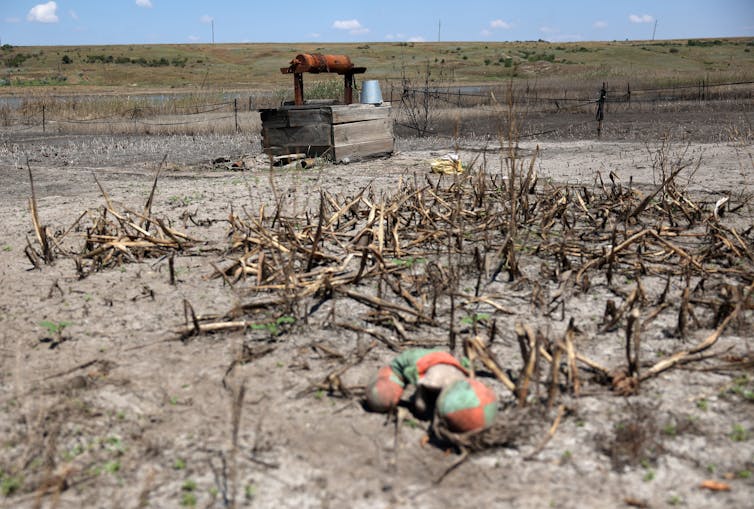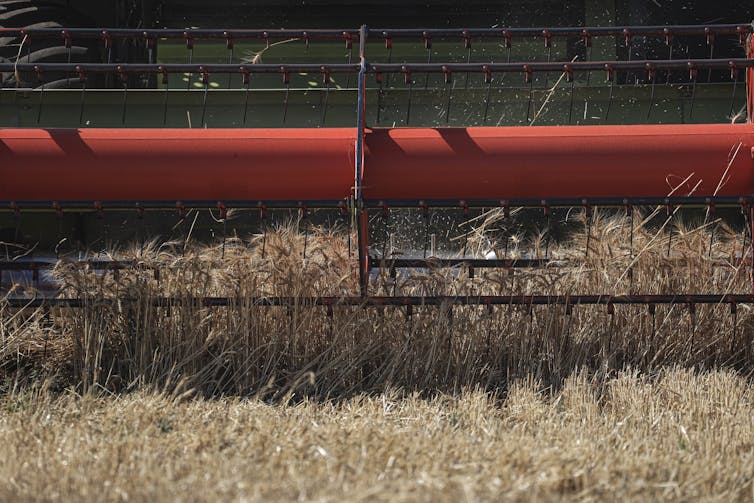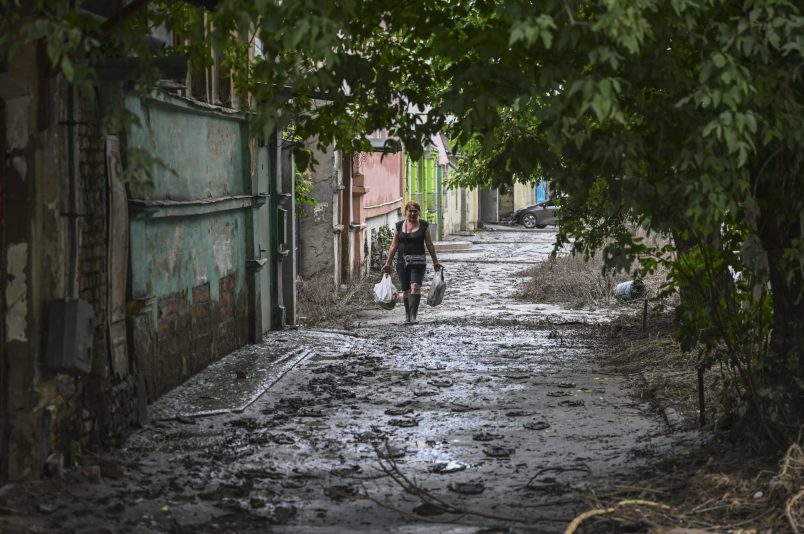This article is part of TPM Cafe, TPM’s home for opinion and news analysis. It was originally published at The Conversation.
When an explosion breached the Kakhovka Dam in Ukraine on June 6, 2023, much analysis focused on near-term impacts, including the flooding of the city of Kherson, threats to the Zaporizhzhia Nuclear Power Plant and consequences for Ukrainian military forces’ expected spring offensive against Russian troops.
But the most severe long-term effects will fall on Southeast Ukraine’s farmers.
Villages there were flooded. Roads, train tracks and irrigation canals were washed away. Crops in fields and orchards in the Kherson and Zaporizhzhia region were inundated, then left to shrivel after the water drained.
The long-term ecological disaster will unfold over decades to come. Crimea, once a region known for its sunny beaches and rice fields, could dry up without irrigation.
We are a U.S. political scientist with research expertise on the post-Soviet region and a Ukrainian economist who studies agriculture. While the long-term effects of the dam break are difficult to calculate, we believe that it will have a lasting impact on the climate of southern Ukraine.
Farmland that is no longer irrigated and cultivated because canals are destroyed and the reservoir drained will dry up, becoming more vulnerable to soil erosion and dust storms. Agricultural production could be reduced for years to come, with impacts that ripple through supply chains and affect food security around the world.
As we see it, the dam explosion has all the hallmarks of a scorched-earth strategy, intended to destroy anything that might be useful to the enemy. It is hard to imagine any country inflicting damage this sweeping on its own soil.

A fertile farming region
Like other Soviet hydroelectric projects, the Kakhovka Dam and power plant were hailed as harbingers of progress and a bright socialist future when they were built in 1956 on the Dnieper River. The North Crimean and Dnieper-Kryvyi Rih canals, constructed in the 1960s and 1970s, transported water from the Kakhovka reservoir to Crimea in the south and the Kryvvi Rih iron ore basin and Zaporizhzhia nuclear power plant in the north.
Local villages and towns came to depend on water and electricity from the dam and its reservoir. Some 545,000 acres (220,000 hectares) of arable land in these two regions are irrigated, including over 20% of Kherson’s farmland.
Kherson’s farms grow watermelons and tomatoes. The region’s cherry, apricot, peach, apple and plum orchards produce Ukraine’s sweetest fruits. Southeast Ukraine also grows vast quantities of soy and sunflower seeds, mostly destined for global markets.
Flooded fields, toxic water
The dam breach inundated fields along the Dnieper’s banks. By July 1, the Dnieper River near the Kherson post had returned to its natural level, although a number of settlements in the territory temporarily occupied by Russian forces remained submerged.
Based on conditions that have been reported so far, we expect that this year’s crops in the flooded zone will be waterlogged, and much of the harvest will be destroyed. Valuable perennial crops that relied on irrigation infrastructure fed by the reservoir will be flooded and then parched. Rich and productive topsoil may be washed away. https://www.youtube.com/embed/64NsrW3AVB8?wmode=transparent&start=0 A news report a week after the dam breach shows the scale of the initial flooding.

Farther downstream, the lower Dnieper, Southern Bug and Inhulets river basins have been polluted, imperiling agriculture and drinking water for southern Ukraine. During the dam breach, 150 tons of oil leaked out, and at least 17 gas stations have been flooded. There is widespread concern about impacts on the region’s wildlife, including many types of nesting and migratory birds.
After the flood, water shortages
Flooding from the reservoir also imperiled infrastructure that is critical for Ukraine’s agricultural exports, including irrigation canals, hydraulic pumping stations, river ports and grain terminals.
Most importantly, without water from the reservoir, the fields of Kherson, Zaporizhzhia and Crimea will dry out. Coastal towns on the Sea of Azov, most importantly Berdyansk, have lost their main source of drinking water.
Crimea is particularly dependent on irrigation. Before Russia annexed it in 2014, Crimea’s farms planted rice and corn. After the annexation Ukraine blocked water from flowing to Crimea. When Russia captured Kherson in March 2022, it reopened the North Crimean Canal and allowed the peninsula’s reservoirs to fill.
Without the Kakhovka Reservoir, however, Crimea is unlikely to receive irrigation water for at least a decade. Effectively, the peninsula will turn into a desert with a naval base.
Fewer exports, higher prices
Beyond Ukraine, the dam breach will critically affect global food supplies. Southern Ukraine’s sunflower seeds, soy and cereals are major ingredients for industrially processed foods and livestock feed. They provide the proteins and lipids that are the building blocks of the 21st-century diet.
After these commodities are harvested, they have to be dried, transported domestically, stored and then shipped internationally. Many facilities along the Dnieper and its tributaries are key nodes in the supply chains that connect Ukrainian farms with world markets.
Storage elevators and loading terminals at the port of Kozatske, located just downstream of the dam, were inundated within hours of the breach. The upstream ports of Kamianets-Dniprovska, Nikopol and Enerhodar are closed and likely will be inoperable for years to come.
Global food commodity prices shot up hours after the dam broke, as global grain traders anticipated food commodity shortages. U.N. aid chief Martin Griffiths told the BBC that the impact on food security could be significant.
“… That whole area going down towards the Black Sea and Crimea is a breadbasket not only for Ukraine but also for the world,” Griffiths told the BBC. “It is almost inevitable that we are going to see huge, huge problems in harvesting and sowing for the next harvest. And so what we are going to see is a huge impact on global food security.”

An uncertain future
Loss of the Kakhovka Dam is the latest blow to a region that has suffered heavily during the war. Most fields along the lower Dnieper are littered with mines. NASA satellite images show crops planted in 2022 that were never harvested.
Before the dam breach, the area under cultivation in 2023 in Ukraine had already contracted by 45%, and overall yields had fallen by as much as 60% compared with 2021 before the war. With the loss of the dam and reservoir, harvests are likely to shrink further.
Many residents of the area’s 80 inundated villages are farmers. If and when they are able to return to their land, the fields and orchards may not be able to produce and earn enough to sustain their families, who have already suffered grievously during heavy fighting in Kherson and Zaporizhzhia.
In 1941, Joseph Stalin ordered Soviet troops to destroy the predecessor of the Kakhovka Dam to slow the advancing German army. It was not rebuilt until 1956. Even if postwar relief efforts can replace the Kakhovka Dam more quickly, we expect that droughts between now and then will virtually destroy rural life in southeastern Ukraine as it existed before June 6.
This article is republished from The Conversation under a Creative Commons license. Read the original article.







War crime.
ETA:
Due to allergies, this is as close as I can get to a cat.
No Cattus shall allergenically attack us!
Should NATO join the battle? Does the West draw a line? I can’t believe I’m asking the question, but the dam and the risk to nuclear power plants…is it time?
US is sending them cluster bombs.
Maybe not a good idea??
I don’t think any country in the modern era has gone through so much shit to prove their mettle while the world mainly says, “Well I’m not quite sure you should join our economic or military club.”
Yes, it’s far more complicated than that, I understand. Yes, countries are helping with armaments, but I kinda feel that Ukraine is like the unlucky Ms. Nancy McKeon in a harrowing Lifetime movie scene where her character is literally being kicked in the head by her husband and there’s a crowd of people around them, yelling and no one does a fucking thing, each mistaking screaming for action.